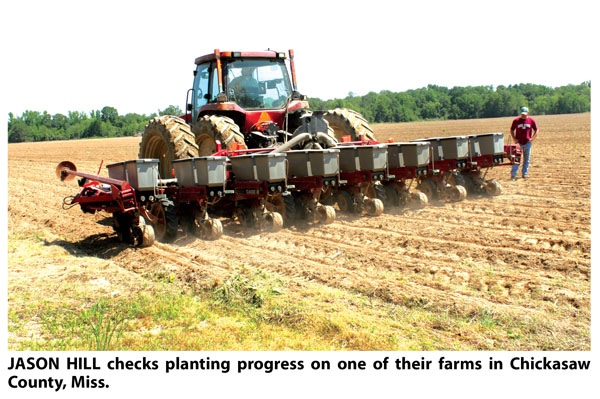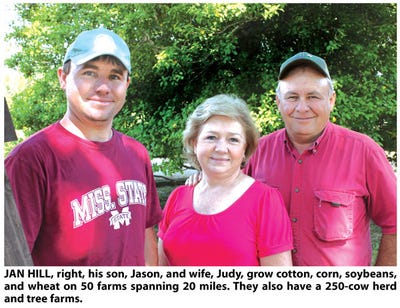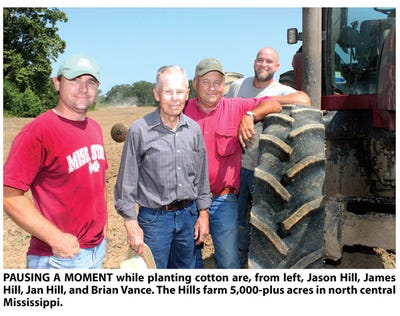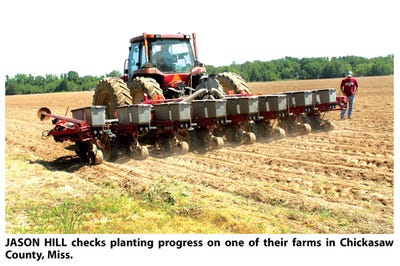
Jan Hill and his son, Jason, work more than 5,000 acres of row crops, pasture/cows, and timber encompassing more than 50 farms and many dozens of fields stretched out across 20 miles of three counties in north central Mississippi. But, says Jan, the fourth generation of his family to farm the bottomlands that weave through wooded hillsides, “If I could grow just one crop, it would be cotton.

Jan Hill and his son, Jason, work more than 5,000 acres of row crops, pasture/cows, and timber encompassing more than 50 farms and many dozens of fields stretched out across 20 miles of three counties in north central Mississippi.
But, says Jan, the fourth generation of his family to farm the bottomlands that weave through wooded hillsides, “If I could grow just one crop, it would be cotton.
“I love cotton. Always have. It’s more challenging, takes more management, and is more expensive to grow than corn or soybeans — but it’s the crop that has kept us in business over the years. Cotton has paid for just about everything we’ve got.
“I can remember selling cotton for as little as 25 cents a pound, and could never have dreamed we’d be seeing the prices  we have now. Last year, I started booking at 90 cents and the last I sold was at $1.17. I averaged about $1.03, which was an all-time record for me. I’ve already booked some of this year’s crop at $1.17.
we have now. Last year, I started booking at 90 cents and the last I sold was at $1.17. I averaged about $1.03, which was an all-time record for me. I’ve already booked some of this year’s crop at $1.17.
“Over the years, I’ve had as much as 1,800 acres of cotton and recently, as little as 700 acres. This year, we’ve cut back some on corn in order to boost cotton, and will have about 1,250 acres.”
A lot of growers who got out of cotton in recent years haven’t gone back, Jan says.
“It’s not cheap to switch crops nowadays, particularly if you don’t have cotton equipment any more. With Bt and Roundup Ready technology, cotton is an easier crop to grow than in the earlier days, but it still requires more management — and a larger investment — than corn or soybeans, and a lot of farmers just don’t want to make that kind of commitment.
“Even with $1 cotton, it’s a big step to buy a half-million-dollar picker. We’ve got two Case IH 2555 four-row pickers; they’re not the latest and greatest, but (he laughs) they’re paid for — and that’s a mighty good feeling.”
They started planting cotton May 6, which Jan says was a bit later than normal.
“We like to start about April 25, but it was just too wet and cold this year. One of the best cotton crops I ever made was planted late, so I’m hoping this year will be another like that.
“We plant mostly Deltapine varieties; this year, we’ll have some 0912 B2RF, which has yielded well for us, along with some 1028 B2RF, 1034 B2RF, and some Phytogen 375, which was mighty good to us last year.
“Year-in, year-out, we’ll average about 800 pounds. Most of the acreage is dryland, though in the last few years I’ve started furrow irrigating some fields from ponds.
Irrigation yield difference striking
“I bought a place four years ago that had eight fish ponds on it, and all I had to do was run polypipe from the ponds to the fields and turn the water on. Thus far, I’ve not had a year when I used anywhere near all the stored water; in fact, water from two of the ponds has been sufficient for irrigation.
“The increase in yield where I’m able to water cotton is striking — at least a 25 percent gain. It looks like our summers are getting consistently drier, and it’s impractical to drill wells here, so I probably will dig additional ponds so I can water more of the cotton fields. The ability to irrigate should also improve corn yields when I rotate to that crop.”
 With Bt technology, plant bugs are about the only insect problem they have to deal with, Jan says, “and we don’t have them nearly as bad as farmers in the Delta. Most years, we’ll spray a couple of times; last year, we didn’t have to spray at all.”
With Bt technology, plant bugs are about the only insect problem they have to deal with, Jan says, “and we don’t have them nearly as bad as farmers in the Delta. Most years, we’ll spray a couple of times; last year, we didn’t have to spray at all.”
Beyond Bt and Roundup Ready technology, he says the Boll Weevil Eradication Program has been “one of the best things the cotton industry has ever done.
“If it wasn’t for the program, we’d have long ago been out of the cotton business. There were many years the weevils just ate us up; there were seasons when I’d spray 22 times — I almost wore the leaves off the cotton from all the times the sprayer went through the fields.
“About the time the eradication program started, they were putting out pheromone traps so they could count and map weevil populations, and every one of our traps would be brimming full of weevils. I don’t think you could’ve ever counted them, there were so many.
“The first time I heard Kenneth Hood [Perthshire, Miss. producer/ginner and one of the leaders of the eradication effort] explain the program and what it could do, I was sold. I haven’t seen a weevil in years; it has made all the difference in the world in growing cotton.”
Bt technology, which provided a dependable weapon against the worms that had almost put a lot of farmers out of business, “was real lifesaver, and has been another tool to help us to stay competitive in world markets,” Jan says. They take their cotton to Vardaman Farmers Gin, about 7 miles up the road.
This year, Jan and Jason will also have 400 acres of corn, 2,000 acres of soybeans, and some wheat. Their operation also includes 800 acres of pasture, on which they run about 250 mama cows, and the rest is in timber, mostly pine.
“Our largest crop field is about 130 acres,” Jan says, “which means we do a lot of shuffling of equipment to get to all our fields.” They have farms in Chickasaw, Webster, and Clay Counties; about half their land is owned, the other half rented.
Rotation improves yields
Nearby Vardaman, Miss., is the center of a major sweet potato production area, and acreage for that crop keeps expanding into adjacent counties.
“I’m probably the only farmer in the area who doesn’t grow sweet potatoes,” Jan says, “though I do rent some of my land to those who grow them. I’ve got 350 acres rented out this year for sweet potatoes — they’re an excellent rotational crop for cotton.
 “Beyond that, we like to do a two-year cotton, one-year corn rotation on all our cotton ground. We see a significant benefit in cotton the year following corn.
“Beyond that, we like to do a two-year cotton, one-year corn rotation on all our cotton ground. We see a significant benefit in cotton the year following corn.
“We started growing corn in about 1996, as much for the rotational benefit as anything. We were working a lot of fields that had always been in cotton, and the ground needed some change.
“Our corn is primarily Pioneer varieties, although we’ve added a good bit of Dekalb this year in order to spread the risk. We’ll average about 130 bushels, which isn’t bad for dryland corn. We’ll do better than that on the cotton ground, but not as good on the heavier soils.
“All the corn is up and growing; we’ve applied nitrogen and sprayed it, so we’re pretty much done with it until harvest. We’ll probably start cutting it around the first of September.”
Jan says they don’t have any on-farm storage. “Our fields are so scattered, we just haven’t seen a way to make it work. We sell our early corn at the elevator and the rest we sell to Sansing Hog Farm over in the next county. This has been a good arrangement for us.”
Son Jason, who is the fifth generation of Hills to farm here, pretty much looks after the soybeans.
“This year, we’re planting mostly Asgrow varieties, primary Group IVs and Group Vs,” he says. “We started planting May 9 and it usually takes a couple of weeks to get everything done, if the weather cooperates. We’ll usually start harvesting around the 20th of September and average about 35 bushels.”
The beans are marketed through Tom Soya Grain Co.
The Hills soil test regularly to determine fertility needs. “It’s hard to get out enough lime and potash on these soils,” says Jan, “so we’re constantly working with that. We’ve started using poultry litter on all our land, at about 1.5 tons per acre.
“On cotton that I irrigated last year and applied poultry litter, I averaged over 1,100 pounds — which is the highest yield I’ve ever had. And on hay ground where I used poultry litter, I baled the most hay ever, so I’m really pleased at how it has worked out. We’re also seeing a bit of a boost in pH where we’re using the litter.
“For our commercial nitrogen this year, we’re using a dry formulation, which was about the same price as liquid, but is much easier and faster to apply.”
Unusual time for markets
The Hills run about 250 mama cows, mostly Brangus and some Angus. “We’ll put up 900 to 1,000 round hay bales each year, which will take the cows through the winter,” Jan says. Most of the cows are sold through the local sale barn.
“The livestock business is pretty good now — in fact, prices are good for all our enterprises. In my farming career, I can’t ever remember a time when prices have been high for all major crops and cows, too.
“Although the timber business took a nosedive when the housing market crashed, we recently sold a block of 30-year-old pines at a price considerably better than I had expected. On the other hand, we’ve got some big, high quality saw timber that buyers aren’t interested in at all. It’s kind of a fickle market right now.”
The recent spate of destructive tornadoes that came through the South downed quite a few trees on their property and toppling trees mangled a lot of pasture fencing. “We’ve been working pretty steadily to get the fences repaired,” Jan says. “But we were fortunate that our house or buildings escaped harm; a house under construction just down the road was badly damaged by the storms.”
Most of the Hills’ farms are no-till and minimum-till. “We bought a guidance system for one of our tractors last year,” Jan says, “and we’ve been using that accuracy to straighten up a lot of our rows and get everything properly aligned on our fields.
“It’s almost unbelievable how this technology works and what a difference it has made in our operations. Who’d have thought a few years ago that one day you’d have a tractor that would steer itself in a perfectly straight line down the field?”
The Hills have three full-time employees and some of Jan’s retired friends help out at busy times of the year. Jan’s wife, Judy, laughingly says she is “bookkeeper, cook, and errand girl.” She and Jan enjoy having Jason, his wife, Kelly, and their grandchildren, Katelyn, 7, and Tyler, 2, just down the road.
“There’s a lot of work looking after everything,” Jan says of their scattered operations. “We never run out of something to do.”
His great-grandfather, J. P. Hill, settled here in the 1800s and farmed all his life, followed by his grandfather, Leo Hill.
“My father, James, who is 85 years old, still keeps a hand in the farm,” Jan says. “He’s out in the field today with the planters.”
Jan, who represents the Houston, Miss., branch of the Mississippi Land Bank, is currently the longest-serving member of the bank’s board of directors. He is also active in the Mississippi Farm Bureau Federation, having served on its board and on numerous committees.
He attended Mississippi State University, but he says, “All the time I was there, I couldn’t wait to get back to the farm. It’s all I ever wanted to do; I never had the first thought of doing anything else. Jason has been the same way — all he’s ever wanted to do is farm — and it’s a joy to have him farming with me.”
About the Author(s)
You May Also Like



